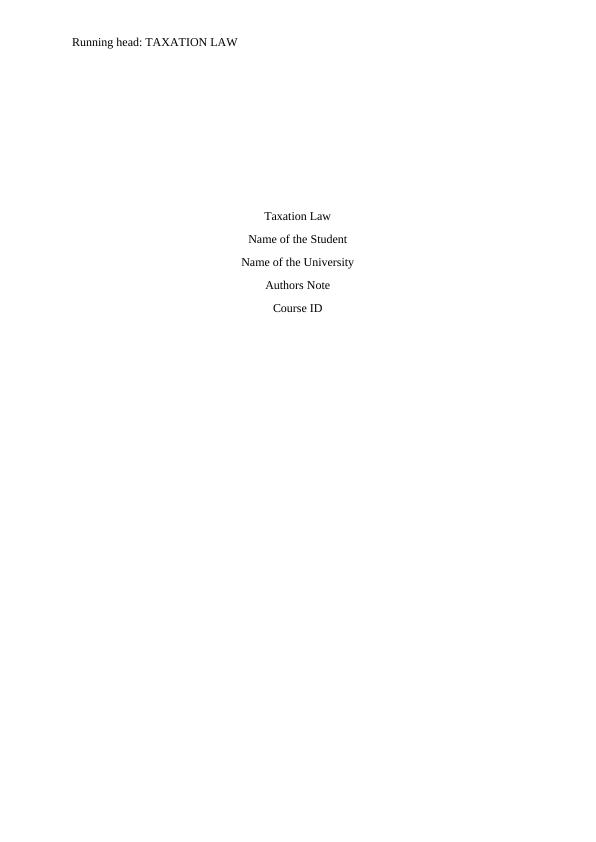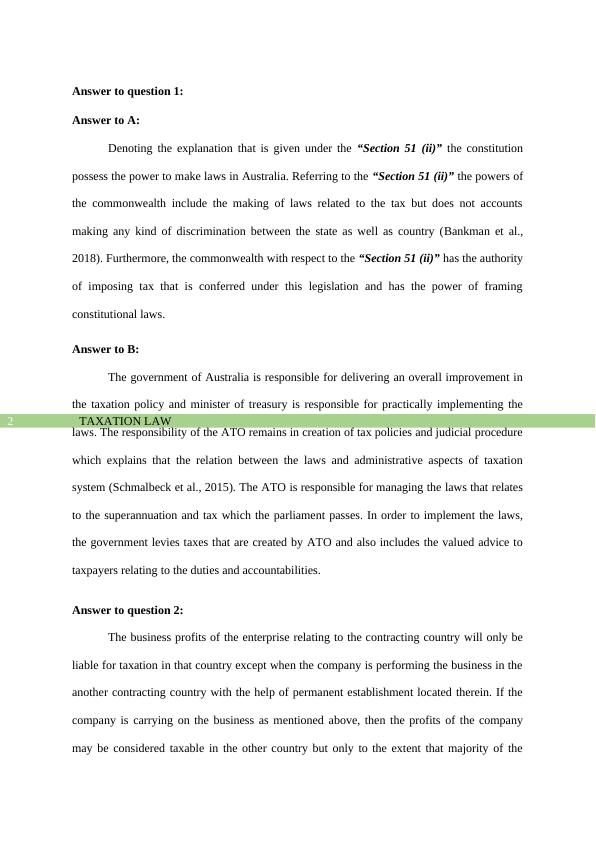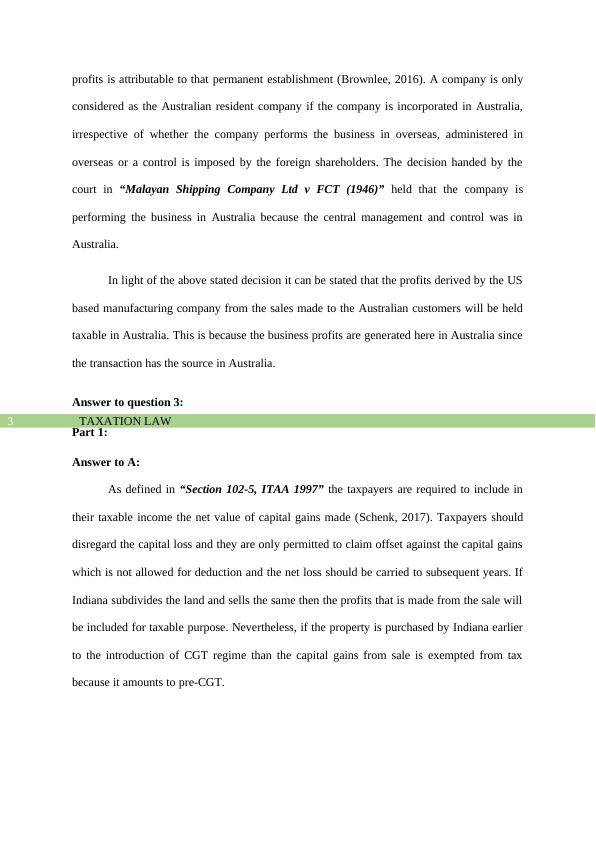Taxation Law
Added on 2022-12-23
12 Pages2811 Words73 Views
Running head: TAXATION LAW
Taxation Law
Name of the Student
Name of the University
Authors Note
Course ID
Taxation Law
Name of the Student
Name of the University
Authors Note
Course ID

TAXATION LAW1
Table of Contents
Answer to question 1:.................................................................................................................2
Answer to A:..........................................................................................................................2
Answer to B:..........................................................................................................................2
Answer to question 2:.................................................................................................................2
Answer to question 3:.................................................................................................................3
Part 1:.....................................................................................................................................3
Answer to A:..........................................................................................................................3
Answer to B:..........................................................................................................................3
Answer to part 2:........................................................................................................................4
Answer to question 4:.................................................................................................................5
Answer to question 5:.................................................................................................................6
Answer to question 6:.................................................................................................................7
Article 1: ATO measures on crackdown on home office expenses claims:...............................7
Article 2: ATO measures of removing “inequitable” inquiry:...................................................8
Answer to question 7:.................................................................................................................8
References:...............................................................................................................................10
Table of Contents
Answer to question 1:.................................................................................................................2
Answer to A:..........................................................................................................................2
Answer to B:..........................................................................................................................2
Answer to question 2:.................................................................................................................2
Answer to question 3:.................................................................................................................3
Part 1:.....................................................................................................................................3
Answer to A:..........................................................................................................................3
Answer to B:..........................................................................................................................3
Answer to part 2:........................................................................................................................4
Answer to question 4:.................................................................................................................5
Answer to question 5:.................................................................................................................6
Answer to question 6:.................................................................................................................7
Article 1: ATO measures on crackdown on home office expenses claims:...............................7
Article 2: ATO measures of removing “inequitable” inquiry:...................................................8
Answer to question 7:.................................................................................................................8
References:...............................................................................................................................10

TAXATION LAW2
Answer to question 1:
Answer to A:
Denoting the explanation that is given under the “Section 51 (ii)” the constitution
possess the power to make laws in Australia. Referring to the “Section 51 (ii)” the powers of
the commonwealth include the making of laws related to the tax but does not accounts
making any kind of discrimination between the state as well as country (Bankman et al.,
2018). Furthermore, the commonwealth with respect to the “Section 51 (ii)” has the authority
of imposing tax that is conferred under this legislation and has the power of framing
constitutional laws.
Answer to B:
The government of Australia is responsible for delivering an overall improvement in
the taxation policy and minister of treasury is responsible for practically implementing the
laws. The responsibility of the ATO remains in creation of tax policies and judicial procedure
which explains that the relation between the laws and administrative aspects of taxation
system (Schmalbeck et al., 2015). The ATO is responsible for managing the laws that relates
to the superannuation and tax which the parliament passes. In order to implement the laws,
the government levies taxes that are created by ATO and also includes the valued advice to
taxpayers relating to the duties and accountabilities.
Answer to question 2:
The business profits of the enterprise relating to the contracting country will only be
liable for taxation in that country except when the company is performing the business in the
another contracting country with the help of permanent establishment located therein. If the
company is carrying on the business as mentioned above, then the profits of the company
may be considered taxable in the other country but only to the extent that majority of the
Answer to question 1:
Answer to A:
Denoting the explanation that is given under the “Section 51 (ii)” the constitution
possess the power to make laws in Australia. Referring to the “Section 51 (ii)” the powers of
the commonwealth include the making of laws related to the tax but does not accounts
making any kind of discrimination between the state as well as country (Bankman et al.,
2018). Furthermore, the commonwealth with respect to the “Section 51 (ii)” has the authority
of imposing tax that is conferred under this legislation and has the power of framing
constitutional laws.
Answer to B:
The government of Australia is responsible for delivering an overall improvement in
the taxation policy and minister of treasury is responsible for practically implementing the
laws. The responsibility of the ATO remains in creation of tax policies and judicial procedure
which explains that the relation between the laws and administrative aspects of taxation
system (Schmalbeck et al., 2015). The ATO is responsible for managing the laws that relates
to the superannuation and tax which the parliament passes. In order to implement the laws,
the government levies taxes that are created by ATO and also includes the valued advice to
taxpayers relating to the duties and accountabilities.
Answer to question 2:
The business profits of the enterprise relating to the contracting country will only be
liable for taxation in that country except when the company is performing the business in the
another contracting country with the help of permanent establishment located therein. If the
company is carrying on the business as mentioned above, then the profits of the company
may be considered taxable in the other country but only to the extent that majority of the

TAXATION LAW3
profits is attributable to that permanent establishment (Brownlee, 2016). A company is only
considered as the Australian resident company if the company is incorporated in Australia,
irrespective of whether the company performs the business in overseas, administered in
overseas or a control is imposed by the foreign shareholders. The decision handed by the
court in “Malayan Shipping Company Ltd v FCT (1946)” held that the company is
performing the business in Australia because the central management and control was in
Australia.
In light of the above stated decision it can be stated that the profits derived by the US
based manufacturing company from the sales made to the Australian customers will be held
taxable in Australia. This is because the business profits are generated here in Australia since
the transaction has the source in Australia.
Answer to question 3:
Part 1:
Answer to A:
As defined in “Section 102-5, ITAA 1997” the taxpayers are required to include in
their taxable income the net value of capital gains made (Schenk, 2017). Taxpayers should
disregard the capital loss and they are only permitted to claim offset against the capital gains
which is not allowed for deduction and the net loss should be carried to subsequent years. If
Indiana subdivides the land and sells the same then the profits that is made from the sale will
be included for taxable purpose. Nevertheless, if the property is purchased by Indiana earlier
to the introduction of CGT regime than the capital gains from sale is exempted from tax
because it amounts to pre-CGT.
profits is attributable to that permanent establishment (Brownlee, 2016). A company is only
considered as the Australian resident company if the company is incorporated in Australia,
irrespective of whether the company performs the business in overseas, administered in
overseas or a control is imposed by the foreign shareholders. The decision handed by the
court in “Malayan Shipping Company Ltd v FCT (1946)” held that the company is
performing the business in Australia because the central management and control was in
Australia.
In light of the above stated decision it can be stated that the profits derived by the US
based manufacturing company from the sales made to the Australian customers will be held
taxable in Australia. This is because the business profits are generated here in Australia since
the transaction has the source in Australia.
Answer to question 3:
Part 1:
Answer to A:
As defined in “Section 102-5, ITAA 1997” the taxpayers are required to include in
their taxable income the net value of capital gains made (Schenk, 2017). Taxpayers should
disregard the capital loss and they are only permitted to claim offset against the capital gains
which is not allowed for deduction and the net loss should be carried to subsequent years. If
Indiana subdivides the land and sells the same then the profits that is made from the sale will
be included for taxable purpose. Nevertheless, if the property is purchased by Indiana earlier
to the introduction of CGT regime than the capital gains from sale is exempted from tax
because it amounts to pre-CGT.

End of preview
Want to access all the pages? Upload your documents or become a member.
Related Documents
Taxation Lawlg...
|12
|2825
|55
Taxation Lawlg...
|12
|3033
|55
Taxation Lawlg...
|12
|2952
|67
Taxation Lawlg...
|12
|2912
|77
Taxation Lawlg...
|12
|2985
|62
Taxation Lawlg...
|11
|2538
|83
